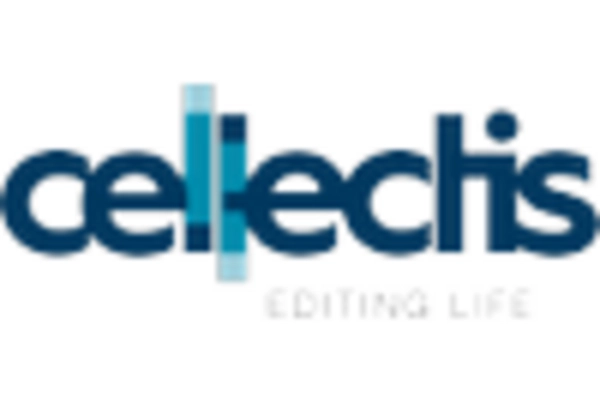Rising Demand for Precision Medicine
The Genome Editing Market is experiencing a notable surge in demand for precision medicine, which tailors treatment to individual genetic profiles. This trend is driven by advancements in genomics and biotechnology, enabling more effective therapies for various diseases. According to recent estimates, the precision medicine market is projected to reach USD 217 billion by 2028, indicating a robust growth trajectory. As healthcare systems increasingly adopt personalized approaches, the Genome Editing Market is poised to benefit significantly, with CRISPR and other editing technologies playing a pivotal role in developing targeted therapies. This shift towards precision medicine not only enhances patient outcomes but also reduces healthcare costs, thereby attracting further investment and innovation within the Genome Editing Market.
Advancements in Regulatory Frameworks
The Genome Editing Market is positively influenced by advancements in regulatory frameworks that facilitate the approval and commercialization of genome editing technologies. Regulatory bodies are increasingly recognizing the potential benefits of these technologies, leading to streamlined approval processes. Recent initiatives have aimed to create clear guidelines for the use of genome editing in both healthcare and agriculture, which is essential for fostering innovation. As regulatory environments become more conducive to the development and application of genome editing solutions, the Genome Editing Market is expected to experience accelerated growth. This evolution in regulatory frameworks not only enhances public trust but also encourages investment and collaboration among stakeholders, ultimately driving the advancement of genome editing technologies.
Expanding Applications in Agriculture
The Genome Editing Market is witnessing a remarkable expansion in agricultural applications, particularly in developing genetically modified crops that are more resilient to environmental stresses. Techniques such as CRISPR-Cas9 are being utilized to enhance crop yield, nutritional value, and resistance to pests and diseases. The global market for genetically modified crops is expected to reach USD 34 billion by 2025, reflecting a growing acceptance of biotechnology in agriculture. This trend is driven by the need to ensure food security amid a rising global population and changing climate conditions. As agricultural stakeholders increasingly recognize the benefits of genome editing, the Genome Editing Market is likely to see accelerated growth, fostering innovation and sustainability in food production.
Growing Awareness of Genetic Disorders
The Genome Editing Market is experiencing growth due to increasing awareness of genetic disorders and the potential for genome editing to address these challenges. As public understanding of genetic diseases expands, there is a rising demand for innovative treatments that can correct genetic mutations. The prevalence of genetic disorders is estimated to affect approximately 1 in 10 individuals globally, highlighting a substantial market opportunity for genome editing solutions. This awareness is driving investment in research and development, as well as collaborations between academic institutions and biotechnology companies. Consequently, the Genome Editing Market is likely to see a surge in the development of therapies aimed at treating genetic disorders, thereby improving patient outcomes and quality of life.
Increased Funding for Research and Development
The Genome Editing Market is benefiting from a significant increase in funding for research and development activities. Governments and private investors are recognizing the potential of genome editing technologies to revolutionize healthcare, agriculture, and other sectors. In recent years, funding for genome editing research has surged, with investments reaching approximately USD 1.5 billion in 2023 alone. This influx of capital is facilitating the development of novel therapies and applications, thereby driving the growth of the Genome Editing Market. As research progresses, new discoveries are likely to emerge, further enhancing the capabilities and applications of genome editing technologies, which may lead to transformative changes across various industries.


















Leave a Comment